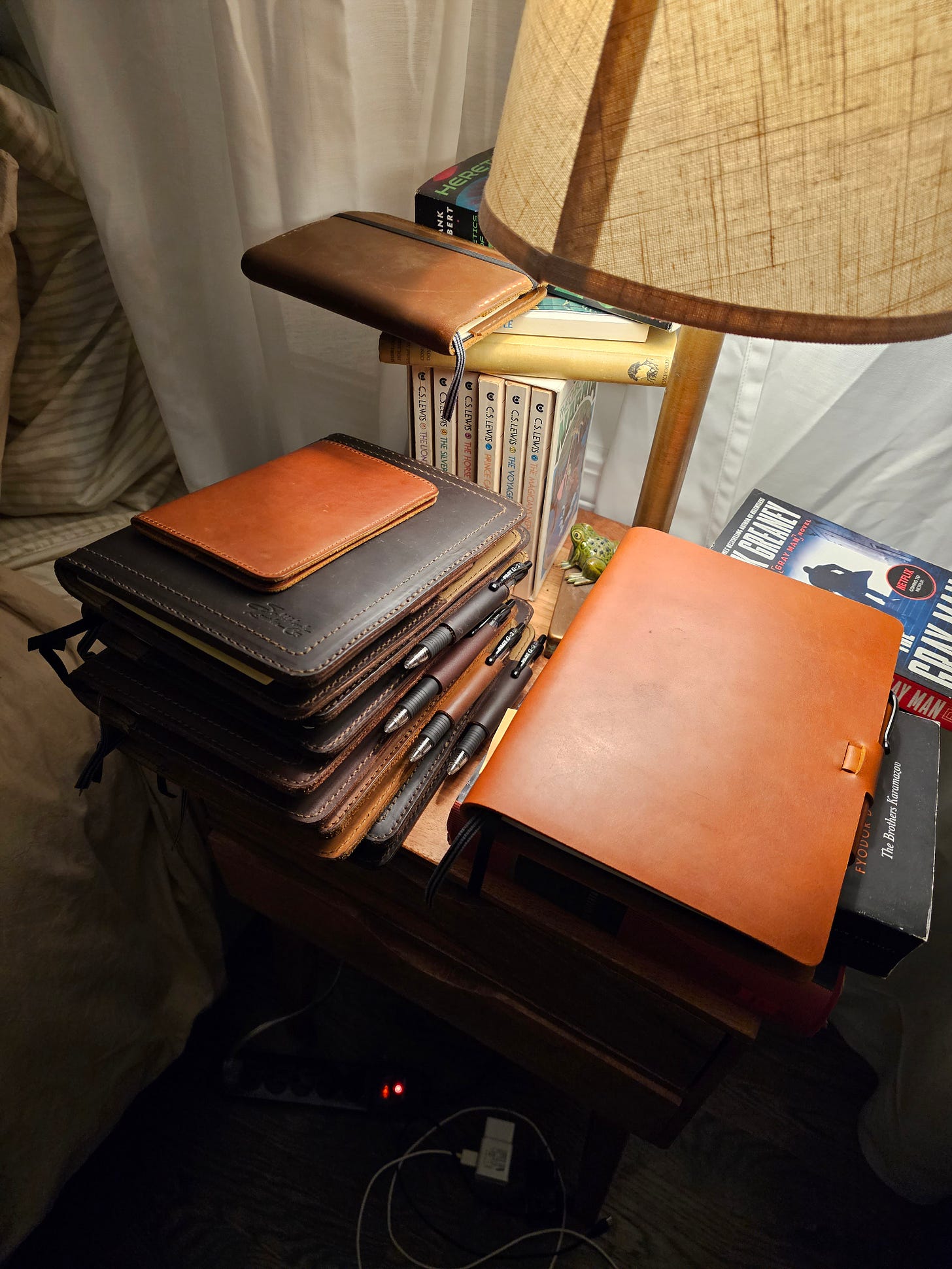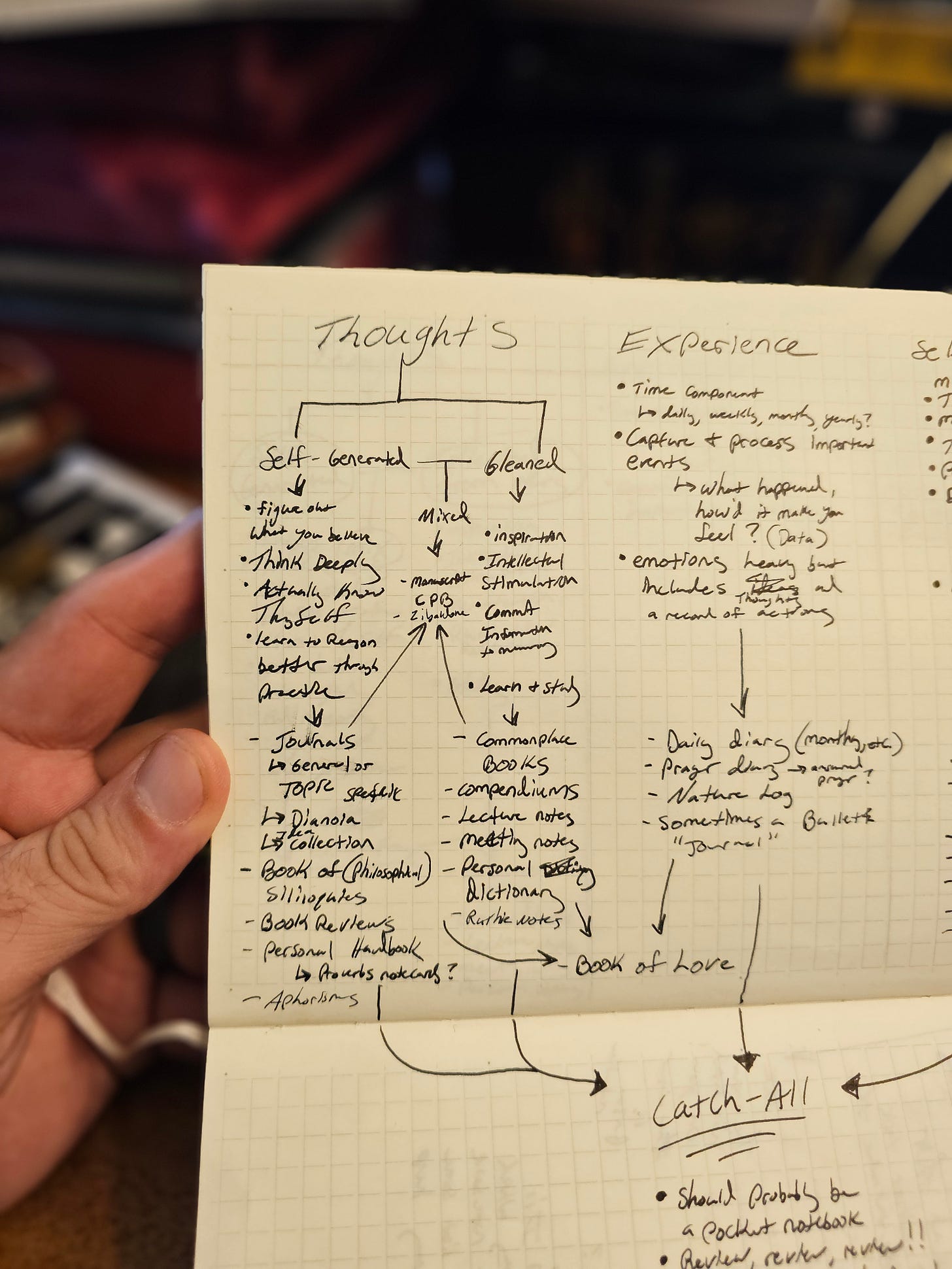The Best Way to Use a Notebook | The Ultimate Guide pt. 1 of 5
I Catalog The Logical Space of All Notebook Methods to Help You Find the Best One For You
I’m sending this out as the second post today! I’m sorry about that. I’m impatient and have a lot of posts I want to write and I have to strike why the ADHD iron is hot. I won’t do this often, I promise.
This post is the first of 5 posts comprising the ultimate guide to using a notebook.
I love notebooks. I’m a big proponent of their use—some would say too big of a proponent, and that very well may be, I’m kind of obsessed.
It all started with a black pocket notebook back when I was in college. That simple Moleskine ended up transforming my life. It’s really a simple thing—just a mini notebook with an elastic band to keep it shut. But with it, I was able to write down all those ideas, thoughts, memories, to-dos, ratiocinations, connections, names, ruminations, syntheses, and quotes that popped into my mind or floated into my awareness which I used to expend so much mental energy trying so hard to hold onto.
Something so simple ended up drastically improving my life.
I used to lay awake in bed for hours—literally!—being plagued by ideas that didn’t want to be erased by my nightly sleep. I actually hated going to sleep lest I lose what I gained throughout the day, or lest my ideas waylay my mind while I’m trying to power down—both of which happened all too often.
But the pocket notebook saved me from all of that and let me finally sleep in peace.
Now I don’t have to worry about forgetting my best ideas or favorite quotes etc., because I know now that they’re tucked safely away in my pocket notebook. Additionally, the actual process of writing them down helps me clarify, solidify, sharpen, and encoded those things much better as well—which helps me recall them better even without the use of my notebook.
Thanks to the success of my pocket notebook habit, I eventually started developing other kinds of notebook habits as my pocket notebooks started to fill in. I needed a notebook for my own ideas—a place to store then and continue to work them out. And I needed a notebook to store all those quotes that tickled my intellect and punched me in the gut. I’d need a spot for transferring and more fully capturing my time-bound emotions and recording various events in my life. And it’d be good to have a place to put my goals and my plans to accomplish them.
So my pocket notebook blossomed into various other kinds of notebooks. I ended up reinventing the wheel on some methods, like the commonplace book and diary, but I also came up with some methods that I haven’t seen anyone else use, which are based on the philosophical methods of some of my favorite philosophers.
It’s pretty cool to work on a commonplace book for a while and then discover it’s a method used throughout western history going back to Roman rhetoricians like Quintilian. It’s also pretty cool to come up with a new approach that others can benefit from too.
Eventually I started sharing my notebook methods with my friends and then my blog readers, and then my YouTube audience. People flocked to my notebook stuff in droves and preferred that kind of content way more than my philosophy content. They reached out to me with their own methods and variations and tips and with their own questions. Through this process, I became the accidental notebook czar of YouTube.
I begrudged the title and the burden at first, but I’ve come to embrace it. I am honored to be your notebook czar and if I can help you live your life better by explaining various ways to keep a notebook, then I will!
In this post I’m going to “chart the logical space” of all notebook methods. Now, that’s probably not strictly true, I bet there are some possible notebook methods that I miss in this catalog, but I’m going to chart all the methods I’ve explored, both through the use of reason—deducing and inducing different methods based on the kinds and categories I’ve come up with—and through my own experience—I have explored lots and lots of different and new notebook methods since starting my notebook & philosophy YouTube channel, ParkNotes.
So, I’m going to catalog 30+ notebook methods across my three main categories: thoughts, experience, and self-mastery. There are some methods that overlap between categories and one of those categories needs to be broken down further: thoughts into personal-thoughts and thoughts-of-others. I’ll explain it all below and I’ll explain why and how some of the methods overlap.
This written post is a fleshed out version of the outline I used for a ParkNotes video I did on this catalog of notebook methods. If you’re interested in watching that ParkNotes video, you can find it below.
The outline eventually bloomed into the outline for my forthcoming book, Journal Like a Philosopher. But keep reading because this post is an update and improvement on the outline and the video:
This post is a more detailed catalog which which most likely itself bloom into the introduction to Journal Like a Philosopher.
You’re about to hit a paywall. I keep these posts limited to paid subscribers for a few reasons. I need to fund my other philosophical work and these practical habits posts always generate the most interest. These posts are probably some of my most unique-to-me posts—they’re based on my own habits and life experience. They’re what my paid subscribers are most interested in so I want to say thank you to them for supporting my work. Paid subscribers are the people most likely to buy Journal Like a Philosopher when it comes out so their feedback on these posts are most vital and could end up shaping the final product. And there are a myriad of other reasons as well, but that’s enough apology for now.
If you like my work here or on YouTube, please do consider upgrading to a paid subscription. You’ll get access to this posts and lots of other paid posts and lectures. If you’re a notebook lover, this post will not disappoint you, you have my word as Accidental Notebook Czar. If somehow it does disappoint, you can also leave me a comment as a paid subscriber or message me in the paid subscriber chat and we can talk it out too.
Okay, so let’s jump in with the three initial categories: thoughts, experience, and self-mastery.
Thoughts, Experience, and Self-Mastery
After 12 years of using various notebook methods, I finally saw a pattern emerge. I’d been keeping some notebooks to gather my own thoughts or collect the thoughts of others, some notebooks to capture and process my life experiences and events, and some notebooks to manage my life and help myself stack on track with my goals.
Once I saw this pattern and abstracted out the three categories, the whole world of notebooks opened up and made more sense. I’m not a psychopath after all—no, that’s not true. I’m nuts and you really shouldn’t keep as many notebooks as I do, it’s insane. But this is actually part of my job, so even if it’s crazy, it’s justified.
In the final draft of this catalog, I’ll explain some of the philosophical roots of the trichotomy—yes, it sort of goes back to Plato as do most things—but there would be no Plato without Pythagoras—ah, no, that’s for another time.
For now, I’ll just say there are three broad categories of notebook methods: you can use them for thoughts, be it for your own thoughts—collecting them or actually thinking them through on the page, or both—for collecting and storing the thoughts of others; for capturing and processing events and experiences; and for self-mastery.
I’ll give the desiderata (something that is needed or wanted) of each category and then characterize each individual method after that.
Let’s start with Thoughts and specifically, with your thoughts, or self-generated thoughts.





